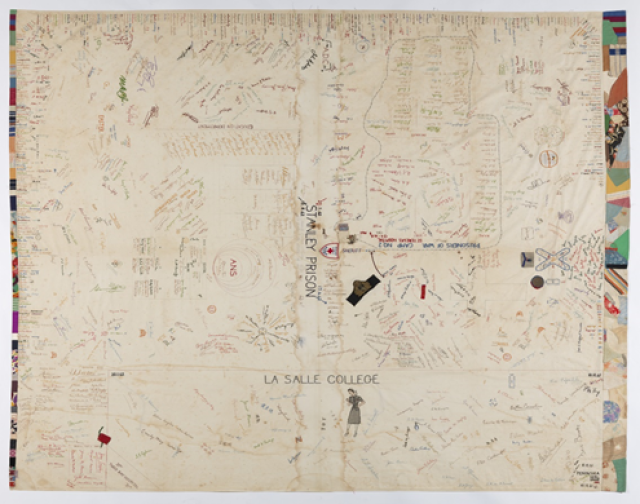| Day Joyce Sheet |
| https://www.iwm.org.uk/collections/item/object/30083388 |
Shortly before Hong Kong surrendered, on 25 December 1941, the Japanese appropriated the hospital. Day and other nurses were forced to remain there until 20 January 1942 when they were interned with the approximately 2,300 other Western civilian men, women and children in the bombed-scarred prison warders quarters of Stanley Prison.
In the centre of the sheet is Day's red and white Auxiliary Nursing Badge. In the bottom right hand corner is written 'Peninsular Hotel Group 8.12.41', which is where Day began her nursing. Starting with La Salle College the narrative continues clockwise.
Day's first nights at Stanley were spent on a camp bed in Tweed Bay hospital, the camp hospital created by the internees. The triangled-off area on the sheet, dated 20-21 [January 1942] Tweed Bay Hospital, marks her first forty-eight hours there. Later she records the thirty-seven men and women who squatted in the small family 'flat' (Block 4 flat 4) on the first floor into which Day next moved. Day was in room 17, fourteen feet by eleven feet, sewn to scale on the sheet. It had a window onto the veranda.
A little red bag on the sheet was made from hospital screen material and has her name and room number on it in white. The bag contained the remains of her watch-she wore the bag pinned to her dress.
The camp school where Day taught for a while is clearly embroidered, as are the names of Betty Gibbons, its headmistress; Professor Lancelot Forster, who headed the children's education in the camp; and Miss Kathleen Anderson who started the kindergarten.
Day also entered all the British, Dutch and American councils as they were formed. The British Communal Council, which eventually ran the camp, is marked clearly on the sheet. The signature of Sir Franklin Gimson, the Colonial Secretary and leader of the British Communal Council and the camp, is embroidered in gold coloured thread.
The last day on the calendar is marked with a large 'Q.'
Near the middle of the sheet is a section marked 'St Theresa's Hospital', which was used as a military hospital for Allied prisoners of war for a few months in 1942 and 1943. It was located on the Hong Kong mainland near the Argyle Street POW camp where all Allied officers were held. Some nurses in Stanley camp were concerned about their loved ones who they thought were imprisoned in this camp. After negotiations between the Japanese and the Colonial Secretary, Mr. Gimson, and Dr. Selwyn Clarke, the Director of Medical Services in Hong Kong, it was finally agreed that eleven nurses, including Day, should be transferred to St. Theresa's. They left Stanley on 16 June 1942. Day took her sheet with her sewn into her folded brown blanket and her pyjamas at the bottom of her basket. The Japanese checked the basket but let its contents through.
Day's time at St. Theresa's is marked on the sheet as 'Prisoner of War camp 2' and is stitched round in grey cotton in a stitch resembling barbed wire. While at St. Theresa's, Day continued to sew the sheet in her spare time. The colour classification of the embroidered names is blue for naval officers and ratings, green for 'proper army' and brown for volunteers. One important name is the Q.A. nursing sister, Muriel Thomson, the matron at St. Theresa's.
On 31 December 1943 she signed off her coded-diary saying: 'it had gone on long enough' (Joyce 1974: 244). It is unclear whether she means the diary or internment, or perhaps both.
On 18 March 1945 Day resumed sewing. In April 1945 she began work in the camp Leprosarium (which became a T.B. clinic in camp). Some of the patients' names are embroidered on the sheet. Day wrote 'my needle is still rusting in one patient's name' (Joyce 1974: 258). The needle is broken off in the name Betty Grant.
Down the right and left hand vertical edges of the sheet is a 'patchwork' of small pieces of material. Each piece of material is taken from different internees' clothes and represented someone or something in Day's internment life. The very bright red and white material Day says 'is' Edith Rawlings. The pretty pale blue she says 'is' Katherine. A terracotta piece is the nearest to the red tie worn by Max Bickerton, and there is a khaki sample of Bicky's shorts nearby. Day herself is represented by a thin piece of muslin with a hole in it. 'My best night dress had to be arranged with the muslin in front and the hole behind' (Joyce 1974: 212).
Sources : Cultural Heritage and Prisoners of War : Creativity Behind Barbed Wire by Gilly Carr , and Harold Mytum (2012)
